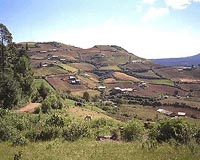 |
West Lafayette IN (SPX) Feb 22, 2010 Resistant wheat plants stave off attacks by Hessian fly larvae by essentially destroying the fly's midgut and its ability to absorb nutrients, according to a study by Purdue University and the U.S. Department of Agriculture. Hessian fly larvae midguts - similar to human intestines - were observed in three different feeding situations. Larvae on susceptible plants had normal midgut function. Those that were given nothing to eat showed no damage to the midgut, though they starved. But those on plants resistant to Hessian flies showed serious midgut disruption. Richard Shukle and Christie Williams, research scientists with the USDA Agricultural Research Service Crop Production and Pest Control Research Unit and Purdue adjunct associate professors of entomology, and Subhashree Subramanyam, a research associate in agronomy, had their findings published in the early online edition of the Journal of Insect Physiology. Shukle said that within three hours, larvae feeding on resistant wheat had abnormal microvilli, fingerlike appendages that extend inward from the walls of the midgut to increase surface area for nutrient absorption. By six hours, the microvilli were nearly destroyed and the midgut was void of food. "Some chemical or compound they're encountering from the resistant plant is causing the microvilli to become disrupted, and it's happening very quickly," Shukle said. "The midgut is certainly one of the major targets of the defense compounds elicited from a resistant plant. There could be other targets, but the midgut is a major target." The research also showed that Hessian fly midguts are lacking a peritrophic membrane, a common insect feature that protects the microvilli from toxic substances. Hessian flies cause considerable damage to wheat crops, with grain yields reduced as much as 20 bushels per acre with moderate infestation levels. There are about a half dozen undeployed genes identified in wheat that offer high resistance to Hessian flies and could be deployed to defend the plants. But understanding how the resistance genes stave off Hessian flies is important because the fly has overcome or is overcoming several genes initially deployed to protect wheat lines. Williams and Subramanyam believe lectins could be one of the toxic substances causing the midgut disruption. Lectins are proteins that bind carbohydrates. Williams said resistant wheat plants contain higher levels of proteins made by the Hessian fly responsive genes, called Hfr-1 and Hfr-3, than susceptible plants. Studies have shown that the protein made by Hfr-1 is a lectin, and the protein made by Hfr-3 is lectin-like. The fly larvae activate the genes responsible for resistance, and Williams and Subramanyam believe those genes may be triggering lectin function. "Lectins are one of the toxins in resistant plants, and they are probably targeting the microvilli," Subramanyam said. Shukle said he will next try to determine what is attaching to the microvilli causing the disruption and will test the Hfr-1 protein to see if it is toxic to the flies.
Share This Article With Planet Earth
Related Links USDA Agricultural Research Service Crop Production and Pest Control Research Unit Farming Today - Suppliers and Technology
 A Review Of Vegetated Buffer Efficacy
A Review Of Vegetated Buffer EfficacyMadison WI (SPX) Feb 22, 2010 Environmental regulators and scientists are making concerted efforts to reduce these pollutions using mitigation tools called best management practices (BMPs). As promising and effective BMPs, vegetated buffers are gradually gaining in popularity. However, lack of quantification on their mitigation efficacies limits their implementation in agricultural fields to reduce nonpoint source pollutions ... read more |
|
| The content herein, unless otherwise known to be public domain, are Copyright 1995-2010 - SpaceDaily. AFP and UPI Wire Stories are copyright Agence France-Presse and United Press International. ESA Portal Reports are copyright European Space Agency. All NASA sourced material is public domain. Additional copyrights may apply in whole or part to other bona fide parties. Advertising does not imply endorsement,agreement or approval of any opinions, statements or information provided by SpaceDaily on any Web page published or hosted by SpaceDaily. Privacy Statement |